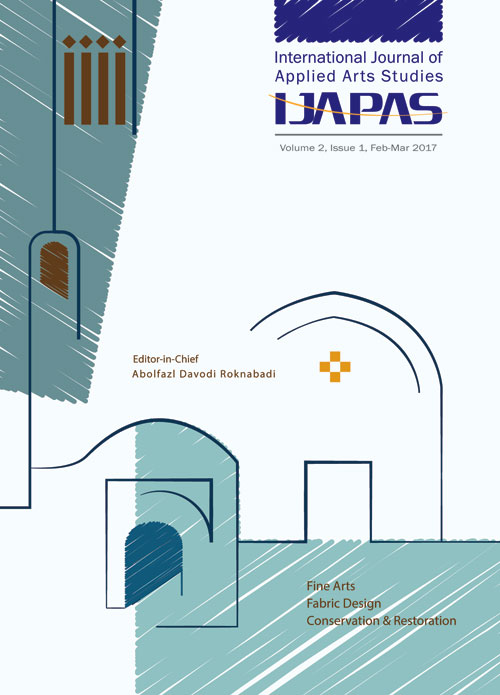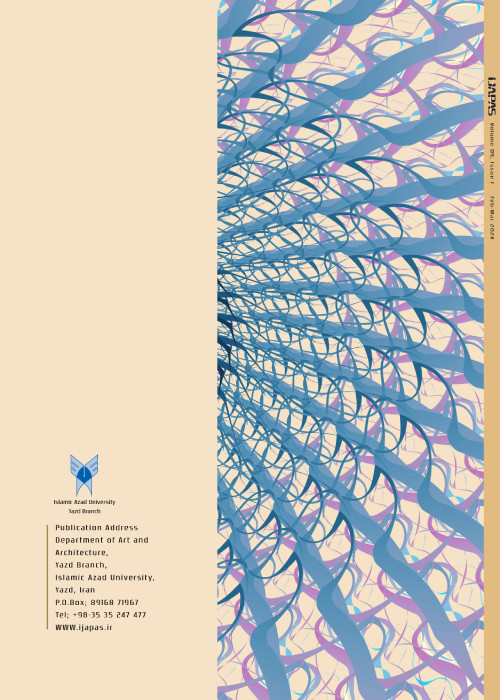فهرست مطالب

International Journal of Applied Arts Studies
Volume:2 Issue: 1, Feb-Mar 2017
- تاریخ انتشار: 1395/12/21
- تعداد عناوین: 6
-
Pages 7-18The suburban caravanserai architecture, considering its environmental and climatic factors, has various patterns in Qom province. The study is related to the caravanserais of the Seljuk period which are limited in number and which have unique structures in terms of physical and architectural features. In Qom province, regardless of research carried out so far on suburban caravanserai architecture, there is still a dearth of studies for a complete understanding, and consequently no accurate typology has been provided for the caravanserai of Qom region yet. Therefore, the typology architecture of caravanserai in Seljuk period is important as a response to the question of what patterns have been followed and what materials were used for the construction? The purpose of this typology is to provide architects with specific patterns in construction. This is a qualitative study conducted through a descriptive-analytic method and sample observation. The samples were selected based on their construction period (i.e., Seljuk), research study and the suburban caravanserai of Qom. The data collection was through field survey and library documents. The results show that division and classification of the suburban caravanserai as regular quadrilateral (i.e., square or rectangle) followed the four-porch construction. This type of caravanserai has a variety of configurations with and without towers; special attention has been given to stone as the main construction material. The entrance to the caravanserai is simple and projects outward from the main façade. The caravanserais are decorated using construction materials that are separated by plaster work from the building façade.Keywords: Qom Province, Suburban Caravanserai, Stone Caravanserai, Typology
-
Pages 19-36Sheikh Lotfollah Mosque is one of the important mosques in Isfahan located on the east side of Naghshejahan Square. The mosque was built from 1602 to 1606 A.D. by Mohammad Reza Isfahani. The structural balance was damaged after the destruction of the school behind the mosque and later the existing bathroom and Turkish closet. Afterwards, in 1934-1938, the project to construct the buttresses began, due to the thrust movement in the north and north-west side of the mosque. Currently, deformation and movement can be observed, despite the presence of these buttresses which are examined in this research using field studies, a careful examination of the buttresses and vulnerability analysis in the area according to library studies. The results of this study verify the presence of ascending moisture caused by leakage of water and sewage pipes in the area as the main reasons for this damage. Therefore, replacement of pipes, foundation grouting and organizing the area are among the restoration project requirements.Keywords: Sheikh Lotfollah Mosque, Buttress, Pathology, Restoration
-
Pages 37-46In this study, a new method has been introduced for the production of upholstery fabric, with a single design feature such as designs without repetition of color features to avoid uniformity in the furniture. In this regard, single fabric design with colors appropriate to sofa structure is considered. The aim is to study the different upholstery fabrics and to reach the starting point for upholstery fabric design. The design can provide feeling of relaxation and comfort for human beings. In today’s stressful life, humans are concerned with the need to see and touch elegancy and simplicity in their surroundings, despite the lack of diversity in upholstery fabric design that cannot fulfill their wishes. Therefore, designs need to be consistent with the theme so that they are integrated in the field and lead the viewer’s sight to the surrounding, as if the design is ongoing.Keywords: Furniture, Upholstery, Design, Fabric
-
Pages 47-54Giveh is footwear worn by men and women appropriate for warm weather and in mountainous areas of Iran. The traditional shoe soles are built with unique material pieces of cloth and are covered with hand-woven cotton or silk. As a unique type of footwear and clothing, Giveh is an integral part of garments. Every country is expected to be a part of preservation and restoration of the culture and to introduce a new generation of useful features as written sources found on the cloth. The aim of the present study is to identify the reasons for the boom in the industry with respect to the components and characteristics of anthropological study considering the manufacturing process of Giveh. It also tries to shed light on the craft and art of the indigenous people, i.e., the way they made the shoes with existing materials and environmental situation around them.Keywords: Giveh, Cover Fabric, Production Process, Giveh Production Industry
-
Pages 55-62Children of any age group are in their objective thinking stage, hence the importance of using tools consistent with their cognitive and mental characteristics. This study uses a descriptive-analytical approach, with an attempt to scrutinize the perception of instructional technology and media effects in conveying the instructional concepts to special kids. As such, a lesson plan based on painting skill was selected for this research study. The participants consisted of 40 male and female students from grade 1-6 elementary school from Ahwaz city (Khouzistan, Iran) which were sampled using systematic cluster sampling method, with an applied and experimental nature. The research tools were the paintings obtained from children both before and after the education. Based on these paintings, a questionnaire with 20-question was designed. The results indicated that using instructional technology and media in a correct and sophisticated manner would facilitate and accelerate better and more efficient teaching of painting to children particularly special kids.Keywords: Instructional Technology, Media, Painting, Special Kids
-
Pages 63-75One way of looking at art is the sociological view. It means looking from the social sciences view, which includes sociology, economics, anthropology, law, and cultural studies. Analyses of mural paintings and decorations in Iranian architecture could also been carried out through a sociological view. This paper aims at presenting an analytical model to evaluate mural paintings and decorations in traditional houses in Yazd in the Qajar era in terms of growth and development by using sociological ideas of Pierre Bourdieu and Thorstein Veblen. The purpose of this paper is therefore to figure out the reasons for the growing of mural paintings of Merchants’ houses in Yazd during the Qajar era and the outcome for their owners. This is done in this paper through a descriptive-analytic technique, which represents the expansion of mural painting of merchants’ houses in Yazd because of the growth in economic capital, cultural capital, and flamboyant consumption of their owners that have led to durability of symbolic capital in that class.Keywords: Qajar Era, Mural Painting, merchants’ class in Yazd, Economic Capital, CulturalCapital, Symbolic Capital, Flamboyant Consumption


